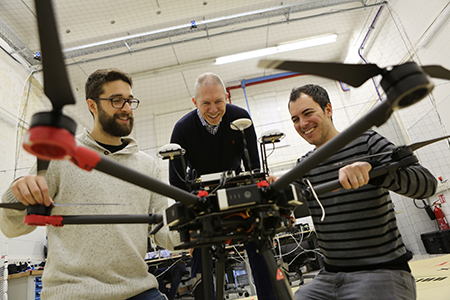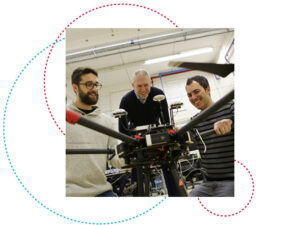« The robots are coming. But not for your jobs. » This is something of a mantra for Dr. Miguel Olivares-Mendez, who has devoted the past five years to building a unique aerial drone lab at the Interdisciplinary Centre for Security, Reliability and Trust (SnT). In fact, he has hung a sign on the door to his office saying as much. From that office he helps lead the Automation & Robotics Research Group at SnT developing new algorithms using artificial intelligence technologies. These algorithms will allow drones (also called unmanned aerial vehicles, UAVs or aerial robots) to assist their human operators intelligently, especially in dangerous situations.
Drones are already in experimental use around the world – just one example is drones being used alongside Alpine rescue dogs in Switzerland. But the UAVs at SnT are different. They are not merely flying cameras that require a human ‘pilot’ on the ground. These drones are smart. They are goal-driven. They are autonomous.
Which is not to say they will become like humans; but, perhaps, they might become more like those Alpine rescue dogs.
The drones at the SnT Aerial Robotics Lab are designed to achieve their goals independently in real-world environments. Like a rescue dog, these autonomous drones need a command from a human handler to start out, but then they can independently maneuver and problem solve to achieve their given task without ongoing human guidance. Not only can they cope with unexpected obstacles, but they can even communicate with each other to accomplish a shared mission.

L-R: Jose Luis Sanchez Lopez, Prof. Holger Voos and Dr. Miguel Angel Olivares-Mendez
Together with their partners at CargoLux, Olivares-Mendez and his team have applied their innovative AI technology in the high-security setting of the Luxembourg airport. They equip their Aerial Robots with high resolution cameras to carry out safety inspections autonomously, right on the airstrip. To address concerns about both data security and possible UAV interference with aircraft, the researchers have gone low-tech, developing drones that fly while attached to retractable cables – a setup that resembles a vacuum cleaner with a retractable power cord. These cables ensure a secure data transmission as well as an unlimited power supply, not to mention rule out any possibility of a drone accidentally going rogue. This unique set up means the SnT Aerial Robotics Lab is the only such lab on Earth with long-term permission to operate their drones on an active airfield.
Working in teams with autonomous drones, airplane inspectors can work uninterrupted conducting safety inspections efficiently. With their autonomous flying partner, inspectors can reliably accomplish more, improving flight safety for everyone.
Olivares-Mendez’s drones are the good guys. They are not here for your job: they are new partners who are here to make your work more efficient. And of course, a whole lot safer.
